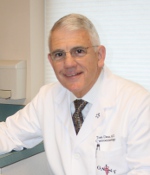Gastroenterologists and endoscopists are beginning to focus more on quality metrics to provide evidence-based treatment for patients.
 "From a quality standpoint, measuring outcomes is important because you can't improve what you don't measure," says Tom Deas Jr., MD, former Medical Director of Fort Worth Endoscopy Center, an affiliate of Surgical Care Affiliates, and Past President of American Society for Gastrointestinal Endoscopy. "An individual physician never really gets a true sense of their skills and performance unless they track themselves against others’ performance and benchmarks. This is one of the best ways for physicians to continuously improve."
"From a quality standpoint, measuring outcomes is important because you can't improve what you don't measure," says Tom Deas Jr., MD, former Medical Director of Fort Worth Endoscopy Center, an affiliate of Surgical Care Affiliates, and Past President of American Society for Gastrointestinal Endoscopy. "An individual physician never really gets a true sense of their skills and performance unless they track themselves against others’ performance and benchmarks. This is one of the best ways for physicians to continuously improve."
Here are 15 quality metrics for gastroenterologists to track.
1. Colonoscopy surveillance rate. Surveillance rate measures whether the gastroenterologist follows recommended surveillance for colonoscopy after negative exams or finding polyps. The benchmark is a five or 10-year follow-up depending on the patient outcome.
"Are you meeting the recommended follow-up rate or are you seeing patients more frequently than recommended?" says Michael Weinstein, MD, Vice President of Capital Digestive Care and Managing Partner for the Metropolitan Gastroenterology Group division. "Figure out your rate and meet the recommended guidelines when possible."
2. Repeat colonoscopy procedures. It's important to track repeat procedures done because the colonoscopy wasn't sufficiently performed the first time, says Dr. Weinstein. Insurance companies and patients will be interested in these numbers. If your repeat colonoscopy procedure rate is high, identify potential areas for improvement.
 "Good preparation is important because if the patient isn't well prepared for the exam, it limits visualization and you have to bring them back for another exam because visualization was compromised during the first one," says Blair Lewis, MD, a gastroenterologist at Mount Sinai Hospital in New York, in connection with The Expert Institute.
"Good preparation is important because if the patient isn't well prepared for the exam, it limits visualization and you have to bring them back for another exam because visualization was compromised during the first one," says Blair Lewis, MD, a gastroenterologist at Mount Sinai Hospital in New York, in connection with The Expert Institute.
3. Anesthesia use. Track whether you use anesthesia and how it's used with different patients. Make sure you are following protocol and recommended guidelines for administering anesthesia to patients in variable situations.
"Adhere to the ASC's guidelines for scope of care so you don't end up doing patients who are ASA class 4 or greater in the ASC setting," says Dr. Lewis. "Physicians must know how to choose which patients should be brought to the center versus which should go to the hospital."
5. Drug prescriptions. Monitor what types of medications you prescribe to patients. "Are you prescribing according to formulary and using generics when you can or are you prescribing more expensive drug alternatives?" says Dr. Weinstein. "There are some IBD clinical measures that some of the carriers respect."
6. Transfers to the hospital or emergency room. Keep track of transfers from the ambulatory surgery center or endoscopy center to the hospital or emergency room.
"They are very infrequent, but unless you are tracking these events against best practice benchmarks, it's difficult to assess how well you are doing," says Dr. Deas. "The frequency of transfers is often related to illness burden or comorbidities of the patients who are chosen for procedures in the ASC. If the transfer rate is high, perhaps you are doing procedures on patients you should be doing in another setting."
 7. Patient falls. Falls among GI patients are often more frequent than other specialties because patients receive moderate sedation, recover more quickly and feel like getting up and moving around without assistance. However, they still may not be completely stable.
7. Patient falls. Falls among GI patients are often more frequent than other specialties because patients receive moderate sedation, recover more quickly and feel like getting up and moving around without assistance. However, they still may not be completely stable.
"In other procedures patients receive general anesthesia and are not allowed to get out of bed, ambulate, or dress themselves.," says Dr. Deas. "With GI/endoscopy, they receive moderate sedation and are up moving around, so fall rate is a good metric for the facility to track."
8. Injury to the bowel. Gastroenterologists should track cautery burns that lead to bleeding or perforation injury to the bowel. These are currently facility quality measures reported to CMS. Tracking these events and identifying trends in these occurrences may allow for interventions that will reduce the risk for future patients.
9. Success of advancing the scope. One of the important metrics for individual physicians includes the success of advancing the scope all the way to the cecum during colonoscopy, says Dr. Deas. "Successful cecal intubation should occur for 90 to 95 percent of colonoscopy, but there is currently a wide variability among specialists."
10. Detection rate. Physicians should measure their adenoma detection rate and work to ensure they are hitting appropriate benchmarks. "Some physicians may have a 45 to 50 percent adenoma detection rate (ADR)," says Dr. Deas. "They have good technique and visualization skills allowing them to identify small polyps. At the other end of the spectrum, some physicians may have ADRs of 10 to 15 percent."
Physicians at the low end of the spectrum can improve their rate by observing and working with experienced physicians with good ADRs.
11. Patient satisfaction. Overall patient satisfaction is important to track and identify areas for improvement. Track the frequency of on-time starts for procedures as it's tied to patient satisfaction, along with other potential factors. "Conduct surveys of patients and make sure they are happy with their care," says Dr. Lewis. "Otherwise make improvements."
12. Documentation adequacy. Endoscopists should measure the consistency of their procedural documentation and track the frequency of deficiencies. "When you produce a procedure report, are you documenting what you did, sedation, ASA status, discharge instructions and what patients should do if they experience problems after a test?" says Dr. Deas. "Documentation in patient records is important for reimbursement and further treatment."
13. Utilization rates. Some third party payers are concerned with over utilization. Track endoscopy utilization rates to show your procedure decisions are appropriate and improve patient health without over utilizing resources.
"There's a reason why people should pursue quality measures," says Dr. Lewis. "Third party payers are concerned with over utilization of endoscopic services, including early recall or colonoscopy and not following national guidelines."
14. Quality of preparation. Preparation for an exam is extremely important because if the patient isn't prepped appropriately, it could compromise the results. More gastroenterologists are taking responsibility for the preparation process than in the past to ensure it's done correctly.
"The payers think it's the physician's job to prepare patients, so it's important to take preparation seriously," says Dr. Lewis. "Identify patients that need extra prep upfront. The physicians are going to become more responsible for the quality of patient prep in the future."
15. Patient interaction and education. Ambulatory surgery centers and endoscopy centers are now taking more time to reach out to patients and educate them so they are aware of their exams. "That interaction can be measured by going to the website and answering questions for the program," says Dr. Lewis. "There are practices that are outsourcing this preparation so the companies contact the patient to make sure they understand the preparation process. Poor preparation leads to over utilization."
More Articles on Gastroenterology:
18 Statistics About GI/Endoscopy in Surgery Centers
GI Diagnostics & Treatment: 3 Revolutionary Trends
7 Ways to Use Key Quality Metrics to Improve Gastroenterology Centers
 "From a quality standpoint, measuring outcomes is important because you can't improve what you don't measure," says Tom Deas Jr., MD, former Medical Director of Fort Worth Endoscopy Center, an affiliate of Surgical Care Affiliates, and Past President of American Society for Gastrointestinal Endoscopy. "An individual physician never really gets a true sense of their skills and performance unless they track themselves against others’ performance and benchmarks. This is one of the best ways for physicians to continuously improve."
"From a quality standpoint, measuring outcomes is important because you can't improve what you don't measure," says Tom Deas Jr., MD, former Medical Director of Fort Worth Endoscopy Center, an affiliate of Surgical Care Affiliates, and Past President of American Society for Gastrointestinal Endoscopy. "An individual physician never really gets a true sense of their skills and performance unless they track themselves against others’ performance and benchmarks. This is one of the best ways for physicians to continuously improve."Here are 15 quality metrics for gastroenterologists to track.
1. Colonoscopy surveillance rate. Surveillance rate measures whether the gastroenterologist follows recommended surveillance for colonoscopy after negative exams or finding polyps. The benchmark is a five or 10-year follow-up depending on the patient outcome.
"Are you meeting the recommended follow-up rate or are you seeing patients more frequently than recommended?" says Michael Weinstein, MD, Vice President of Capital Digestive Care and Managing Partner for the Metropolitan Gastroenterology Group division. "Figure out your rate and meet the recommended guidelines when possible."
2. Repeat colonoscopy procedures. It's important to track repeat procedures done because the colonoscopy wasn't sufficiently performed the first time, says Dr. Weinstein. Insurance companies and patients will be interested in these numbers. If your repeat colonoscopy procedure rate is high, identify potential areas for improvement.
 "Good preparation is important because if the patient isn't well prepared for the exam, it limits visualization and you have to bring them back for another exam because visualization was compromised during the first one," says Blair Lewis, MD, a gastroenterologist at Mount Sinai Hospital in New York, in connection with The Expert Institute.
"Good preparation is important because if the patient isn't well prepared for the exam, it limits visualization and you have to bring them back for another exam because visualization was compromised during the first one," says Blair Lewis, MD, a gastroenterologist at Mount Sinai Hospital in New York, in connection with The Expert Institute. 3. Anesthesia use. Track whether you use anesthesia and how it's used with different patients. Make sure you are following protocol and recommended guidelines for administering anesthesia to patients in variable situations.
"Adhere to the ASC's guidelines for scope of care so you don't end up doing patients who are ASA class 4 or greater in the ASC setting," says Dr. Lewis. "Physicians must know how to choose which patients should be brought to the center versus which should go to the hospital."
5. Drug prescriptions. Monitor what types of medications you prescribe to patients. "Are you prescribing according to formulary and using generics when you can or are you prescribing more expensive drug alternatives?" says Dr. Weinstein. "There are some IBD clinical measures that some of the carriers respect."
6. Transfers to the hospital or emergency room. Keep track of transfers from the ambulatory surgery center or endoscopy center to the hospital or emergency room.
"They are very infrequent, but unless you are tracking these events against best practice benchmarks, it's difficult to assess how well you are doing," says Dr. Deas. "The frequency of transfers is often related to illness burden or comorbidities of the patients who are chosen for procedures in the ASC. If the transfer rate is high, perhaps you are doing procedures on patients you should be doing in another setting."
 7. Patient falls. Falls among GI patients are often more frequent than other specialties because patients receive moderate sedation, recover more quickly and feel like getting up and moving around without assistance. However, they still may not be completely stable.
7. Patient falls. Falls among GI patients are often more frequent than other specialties because patients receive moderate sedation, recover more quickly and feel like getting up and moving around without assistance. However, they still may not be completely stable."In other procedures patients receive general anesthesia and are not allowed to get out of bed, ambulate, or dress themselves.," says Dr. Deas. "With GI/endoscopy, they receive moderate sedation and are up moving around, so fall rate is a good metric for the facility to track."
8. Injury to the bowel. Gastroenterologists should track cautery burns that lead to bleeding or perforation injury to the bowel. These are currently facility quality measures reported to CMS. Tracking these events and identifying trends in these occurrences may allow for interventions that will reduce the risk for future patients.
9. Success of advancing the scope. One of the important metrics for individual physicians includes the success of advancing the scope all the way to the cecum during colonoscopy, says Dr. Deas. "Successful cecal intubation should occur for 90 to 95 percent of colonoscopy, but there is currently a wide variability among specialists."
10. Detection rate. Physicians should measure their adenoma detection rate and work to ensure they are hitting appropriate benchmarks. "Some physicians may have a 45 to 50 percent adenoma detection rate (ADR)," says Dr. Deas. "They have good technique and visualization skills allowing them to identify small polyps. At the other end of the spectrum, some physicians may have ADRs of 10 to 15 percent."
Physicians at the low end of the spectrum can improve their rate by observing and working with experienced physicians with good ADRs.
11. Patient satisfaction. Overall patient satisfaction is important to track and identify areas for improvement. Track the frequency of on-time starts for procedures as it's tied to patient satisfaction, along with other potential factors. "Conduct surveys of patients and make sure they are happy with their care," says Dr. Lewis. "Otherwise make improvements."
12. Documentation adequacy. Endoscopists should measure the consistency of their procedural documentation and track the frequency of deficiencies. "When you produce a procedure report, are you documenting what you did, sedation, ASA status, discharge instructions and what patients should do if they experience problems after a test?" says Dr. Deas. "Documentation in patient records is important for reimbursement and further treatment."
13. Utilization rates. Some third party payers are concerned with over utilization. Track endoscopy utilization rates to show your procedure decisions are appropriate and improve patient health without over utilizing resources.
"There's a reason why people should pursue quality measures," says Dr. Lewis. "Third party payers are concerned with over utilization of endoscopic services, including early recall or colonoscopy and not following national guidelines."
14. Quality of preparation. Preparation for an exam is extremely important because if the patient isn't prepped appropriately, it could compromise the results. More gastroenterologists are taking responsibility for the preparation process than in the past to ensure it's done correctly.
"The payers think it's the physician's job to prepare patients, so it's important to take preparation seriously," says Dr. Lewis. "Identify patients that need extra prep upfront. The physicians are going to become more responsible for the quality of patient prep in the future."
15. Patient interaction and education. Ambulatory surgery centers and endoscopy centers are now taking more time to reach out to patients and educate them so they are aware of their exams. "That interaction can be measured by going to the website and answering questions for the program," says Dr. Lewis. "There are practices that are outsourcing this preparation so the companies contact the patient to make sure they understand the preparation process. Poor preparation leads to over utilization."
More Articles on Gastroenterology:
18 Statistics About GI/Endoscopy in Surgery Centers
GI Diagnostics & Treatment: 3 Revolutionary Trends
7 Ways to Use Key Quality Metrics to Improve Gastroenterology Centers


